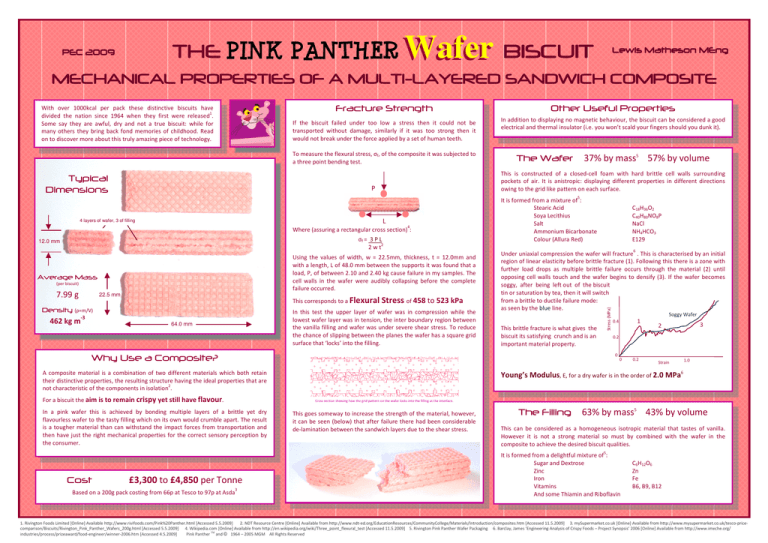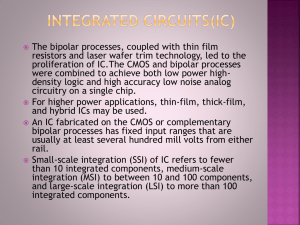
THE PINK PANTHER Wafer BISCUIT
PEC 2009
Lewis Matheson MEng
MECHANICAL PROPERTIES OF A MULTIMULTI-LAYERED SANDWICH COMPOSITE
Fracture Strength
With over 1000kcal per pack these distinctive biscuits have
1
divided the nation since 1964 when they first were released .
Some say they are awful, dry and not a true biscuit: while for
many others they bring back fond memories of childhood. Read
on to discover more about this truly amazing piece of technology.
If the biscuit failed under too low a stress then it could not be
transported without damage, similarly if it was too strong then it
would not break under the force applied by a set of human teeth.
To measure the flexural stress, σf, of the composite it was subjected to
a three point bending test.
Typical
Dimensions
Other Useful Properties
In addition to displaying no magnetic behaviour, the biscuit can be considered a good
electrical and thermal insulator (i.e. you won’t scald your fingers should you dunk it).
The Wafer
37% by mass5 57% by volume
This is constructed of a closed-cell foam with hard brittle cell walls surrounding
pockets of air. It is anistropic: displaying different properties in different directions
owing to the grid like pattern on each surface.
P
5
Where (assuring a rectangular cross section)4:
σf = 3 P L
2 w t2
12.0 mm
Using the values of width, w = 22.5mm, thickness, t = 12.0mm and
with a length, L of 48.0 mm between the supports it was found that a
load, P, of between 2.10 and 2.40 kg cause failure in my samples. The
cell walls in the wafer were audibly collapsing before the complete
failure occurred.
Average Mass
(per biscuit)
7.99 g
22.5 mm
This corresponds to a Flexural
Density (ρ=m/V)
-3
462 kg m
Stress of 458 to 523 kPa
In this test the upper layer of wafer was in compression while the
lowest wafer layer was in tension, the inter boundary region between
the vanilla filling and wafer was under severe shear stress. To reduce
the chance of slipping between the planes the wafer has a square grid
surface that ‘locks’ into the filling.
64.0 mm
Under uniaxial compression the wafer will fracture6 . This is characterised by an initial
region of linear elasticity before brittle fracture (1). Following this there is a zone with
further load drops as multiple brittle failure occurs through the material (2) until
opposing cell walls touch and the wafer begins to densify (3). If the wafer becomes
soggy, after being left out of the biscuit
tin or saturation by tea, then it will switch
from a brittle to ductile failure mode:
as seen by the blue line.
This brittle fracture is what gives the
biscuit its satisfying crunch and is an
important material property.
Why Use a Composite?
3
2
0.2
0
For a biscuit the aim is to remain crispy yet still have flavour.
0.2
1.0
Strain
6
Young’s Modulus, E, for a dry wafer is in the order of 2.0 MPa
Cross section showing how the grid pattern on the wafer locks into the filling at the interface.
In a pink wafer this is achieved by bonding multiple layers of a brittle yet dry
flavourless wafer to the tasty filling which on its own would crumble apart. The result
is a tougher material than can withstand the impact forces from transportation and
then have just the right mechanical properties for the correct sensory perception by
the consumer.
£3,300 to £4,850 per Tonne
Based on a 200g pack costing from 66p at Tesco to 97p at Asda
Soggy Wafer
1
0.4
0
A composite material is a combination of two different materials which both retain
their distinctive properties, the resulting structure having the ideal properties that are
not characteristic of the components in isolation2.
Cost
C18H36O2
C40H80NO8P
NaCl
NH4HCO3
E129
Stress (MPa)
L
4 layers of wafer, 3 of filling
It is formed from a mixture of :
Stearic Acid
Soya Lecithius
Salt
Ammonium Bicarbonate
Colour (Allura Red)
3
This goes someway to increase the strength of the material, however,
it can be seen (below) that after failure there had been considerable
de-lamination between the sandwich layers due to the shear stress.
The Filling
63% by mass5 43% by volume
This can be considered as a homogeneous isotropic material that tastes of vanilla.
However it is not a strong material so must by combined with the wafer in the
composite to achieve the desired biscuit qualities.
It is formed from a delightful mixture of5:
Sugar and Dextrose
Zinc
Iron
Vitamins
And some Thiamin and Riboflavin
C6H12O6
Zn
Fe
B6, B9, B12
1. Rivington Foods Limited [Online] Available http://www.rivifoods.com/Pink%20Panther.html [Accessed 5.5.2009]
2. NDT Resource Centre [Online] Available from http://www.ndt-ed.org/EducationResources/CommunityCollege/Materials/Introduction/composites.htm [Accessed 11.5.2009] 3. mySupermarket.co.uk [Online] Available from http://www.mysupermarket.co.uk/tesco-pricecomparison/Biscuits/Rivington_Pink_Panther_Wafers_200g.html [Accessed 5.5.2009] 4. Wikipedia.com [Online] Available from http://en.wikipedia.org/wiki/Three_point_flexural_test [Accessed 11.5.2009] 5. Rivington Pink Panther Wafer Packaging 6. Barclay, James ‘Engineering Analysis of Crispy Foods – Project Synopsis’ 2006 [Online] Available from http://www.imeche.org/
TM
industries/process/prizeaward/food-engineer/winner-2006.htm [Accessed 4.5.2009]
Pink Panther and © 1964 – 2005 MGM All Rights Reserved





